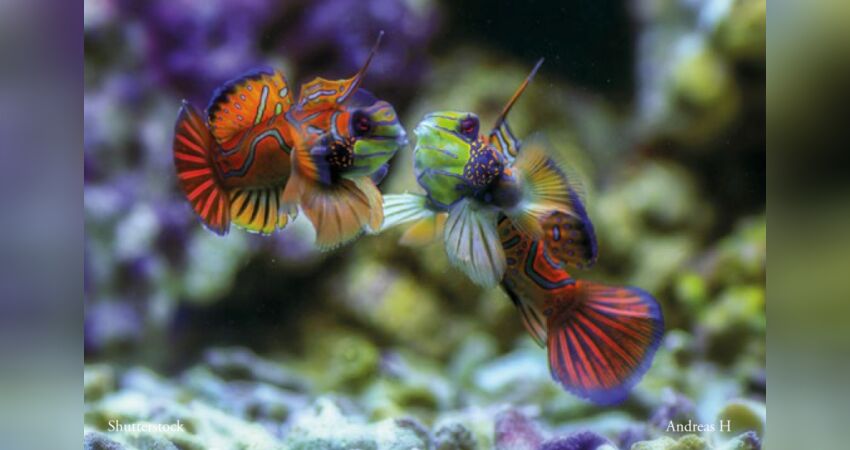Magazine: THE MANDARIN - Synchiropus splendidus
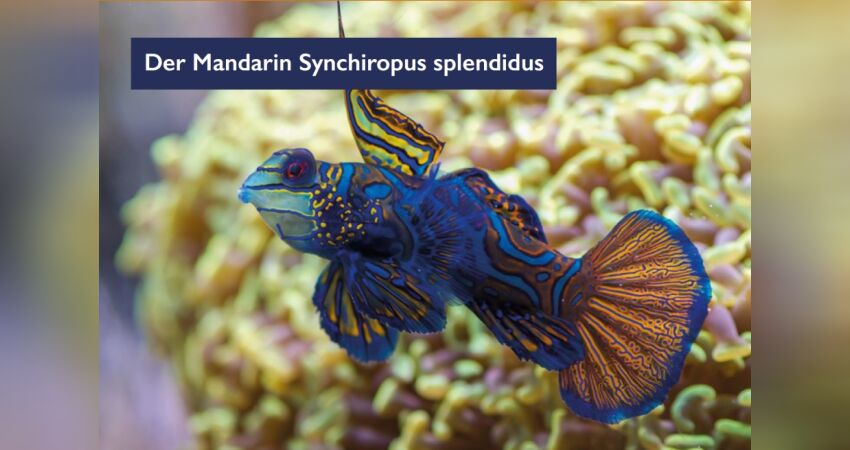
Lyrefish in the aquarium - I have often seen budding aquarists standing in front of a dealer's tank and saying in amazement, "Look, they are so pretty and colourful! They were usually talking about mandarin lyrefish (lat. Synchiropus splendidus), which are among the most striking and colourful fish in coral reefs. From Issue 02 Coral Reef Magazine by Robert Baur
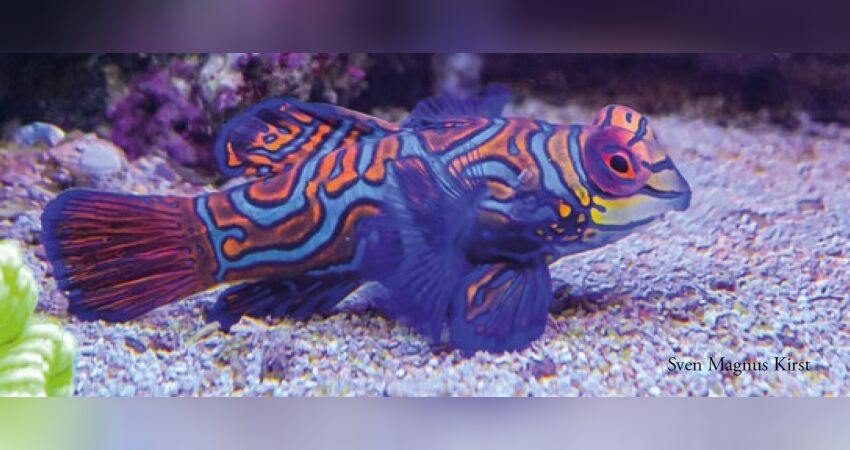
This article is mainly aimed at newcomers to reef aquaristics. Often these fishes are bought impulsively because of their beauty and colorfulness and this without the future keeper having informed himself sufficiently about the fish and its keeping conditions.
Synchiropus splendidus, which is native to the Indo-Australian archipelago and the Western Pacific and is widespread there, is the most traded lyrefish species worldwide due to its colorfulness. No wonder, because whoever has seen this really strikingly marked fish once, can rarely escape its beauty and elegance. According to literature, the animals are among the largest lyrefish with a body length of about 10 centimeters, although most individuals in aquariums reach only about eight centimeters.
The so-called LSD or clown lyrefish (lat. Synchiropus picturatus) ranks second on the popularity scale. This lyrefish remains a little smaller with about 5 cm and has the same distribution area, as well as the same food preferences as Pterosynchiropus splendidus, resulting in very similar requirements of both species for aquarium keeping.
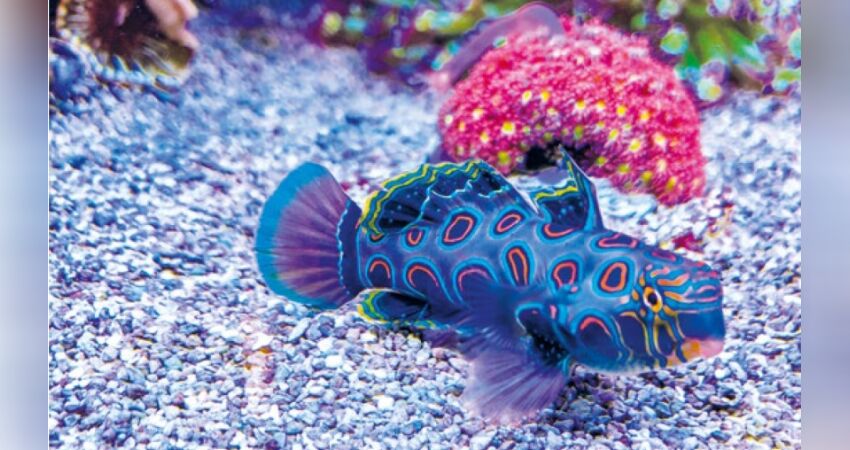
Lyrefishes - Callionymidae:
The lyrefish family (Callionymidae) is taxonomically recorded in 20 genera with approximately 190 species. The most relevant genus for aquaristics is the genus Synchiropus, to which the two species mentioned above belong. Instead of scales, lyrefishes have a firm and very slimy skin, which then gives off a foul odor when the fish comes up for air. In addition to the unpleasant odor, this slime layer also has a very unpleasant taste, which makes the fish unattractive to predators. The mucus of fish, like all fish species, is derived from a glycoprotein called mucin, which is produced in glandular cells and becomes slimy when mixed with water. At night, fish wrap themselves in this mucus to also hide their body odor from enemies. (Saovy et al., 2005).
Lyrefish do not swim by using their caudal fin like other fish, but move slowly gliding with the help of their pelvic fins.
We would like to point out that all lyrefish usually feed only on crustaceans and worms found in the aquarium, and the acceptance of frozen food sometimes takes several weeks. Therefore, you should not put these beautiful fish in your aquarium right at the beginning. These animals are not actually sensitive, but if not enough natural food is available, a lyrefish can quickly starve. A sunken belly is an alarming sign, but it is usually not clearly visible until shortly before the animal dies. Especially after a long transport many of these animals are not "fit". Here only a well run-in tank with a lot of natural food helps.
In a tank at least 10 months old with live stones we would have no concerns. However, this time is only a guideline. As less and less tanks are started with live rock, the microfauna (small crustaceans ect.) also decreases more and more. The establishment of microorganisms therefore takes much longer with dead rock, ceramics or other furnishing materials. For safety reasons, only one animal should be used in such tanks that has been proven to accept frozen food and can be fed selectively several times a day.
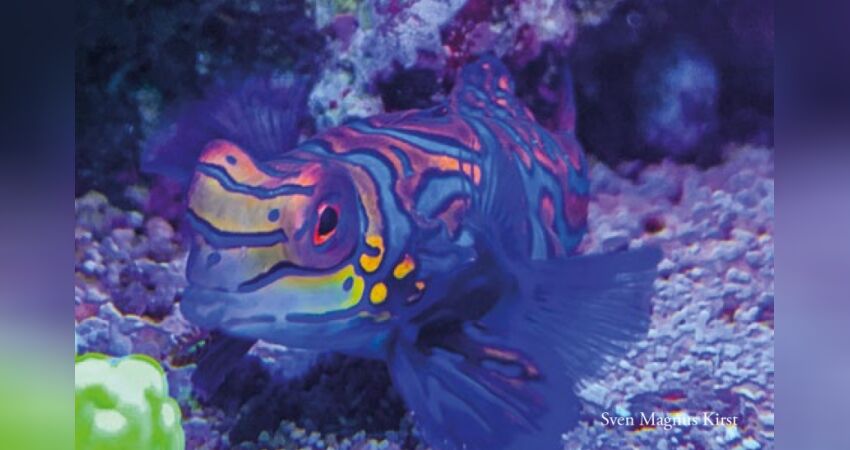
Pair keeping:
As a general rule, you should always keep marine fish in pairs, if possible. This is what we have always done with the Mandarin. On an important hint of Marius Schumann, there is a restriction to pair keeping especially with the mandarin fish (Synchiropus splendidus) regarding the life expectancy.
The mating system of the animals is called "polygynandric". This means that in nature, the animals congregate in small groups and spawn with more of the same group of partners. In mandarinfish, strong males are preferred for mating, which is why a male usually mates with a group of females. Spawning occurs at approximately weekly intervals. This occurs for several months, although the time of year may vary and is not fixed as in other fishes (Delbreek, 1989).
In a pair-housed aquarium, mating readiness cannot be distributed among different mates, which can lead to massive stress. This stress could be one of the main factors why the fish reaches an age of 10-15 years in nature, but mostly only 2-4 years in aquariums with pair keeping. Individually kept specimens usually reach a much higher age of up to 8 years or more. Especially in smaller tanks we advise against keeping them in pairs for these reasons. In large aquariums a group keeping of one male and several females represents the best possible imitation of the natural way of life and should therefore be aimed at.
However, there is one thing you should never do: Put two males of the same species. In our experience this always leads to the death of the inferior male.
The differentiation of the sexes is not so easy with small animals, but with sexually mature animals. The male has a clearly longer first dorsal spine (also called flag), which is missing in females. When the male erects this dorsal spine, the shape resembles an umbrella or, with a lot of imagination, a sword.
Unfortunately, the sexual maturity of the animals can not be determined with certainty by the size of the animals, so in addition to your own assessment, you should ask a good specialist dealer for advice.
Enemies:
In a "normal" reef tank with "normal" animal stocking, there will hardly be an animal that will become dangerous to a lyrefish. The reason should be found in the fact that in the literature it is assumed that the slime layer surrounding a lyrefish is considered poisonous. However, there is a published report in the literature that a moray eel took it upon itself to eat a mandarin despite its layer of slime. We think that when keeping moray eels you should already expect that something like this can happen. Every creature is an individual and can behave in a way that does not correspond to the rule. Other fish, however, will normally pay little attention to a lyrefish.
Spawning dance of the lyre fish:
For a sexually mature pair that is comfortable in the aquarium, the time will soon come. They begin to spawn. The so-called spawning dance of the lyre fish is simply beautiful.
About 30 minutes before the lights are switched off, in the glow of the not so strong blue light, our lyrefish start and meet in the "open water". Especially the male is terribly excited and flutters his pectoral fins like crazy. Our male of S. splendidus pecked very fast one after the other with his mouth against the aquarium pane during all spawning breaks. The female usually makes quite a loose and calm impression, almost as if it doesn't touch her that much.
At about medium aquarium height, which in our case corresponds to about 35 cm, both lyrefish now start to climb up to the water surface together. The male is always a little bit below the female. First side by side, at the surface then belly to belly. This happens at least 30 times in our aquarium until spawning takes place. This happens mostly only when the lighting is switched off completely.
Unfortunately, we cannot answer the reason for these many experiments. Do the animals get in the mood through the repeated attempts? We think that it is possibly also due to the low height of the (our) tank, so that the lyrefish simply need more attempts to catch the right moment. Because in nature, the animals rise one to two meters above the reef, which we unfortunately can't offer them. In any case, it seems to take a lot of practice to get the spawning to happen simultaneously. As an aquarist who cares for lyre fishes you have to be aware that especially the spawning dances of lyre fishes are dangerous. In the many years of keeping Mandarin we have already had two jump out of the tank. Apparently they are so excited during spawning that it comes to one hop too much. One of the two jumpers we could put back, the second unfortunately not. So you should always take good care and if possible attach a high border or a jumping protection to the aquarium.
Breeding:
About a regular breeding of Synchiropus splendidus is unfortunately currently nothing more detailed known to us. There were and still are publications about breeding successes (Wolfgang Mai, 2009), but unfortunately not in large numbers.
We would like to recommend the book "Leierfische - Im Meerwasseraquarium - Pflege und Nachzucht" by Wolfgang Mai from the species-by-species series of KORALLE. There especially the breeding of the animals is discussed.
How do you like this article?
Info
Author

Bookmark
Comments
Topics
Similar articles
- Büschelbarsche - Korallenwächter
- 31 - Surgeonfish Part 3
- Feeding coral fish part 3
- Ein neuer Riffbarsch Hybride
- Fish Catching in the Aquarium | Nyos Floating Fish Trap (Ingenious)
- Nachzucht von Acreichthys tomentosus
- 27 - Angelfish in a community aquarium?
- Aspekte zur Pflege von Fischen im Riffaquarium
- Doryrhamphus pessuliferus wurde gezüchtet
- Quarantäne für Korallenfische
Comments To the top
Please register
In order to be able to write something yourself, you must register in advance.





